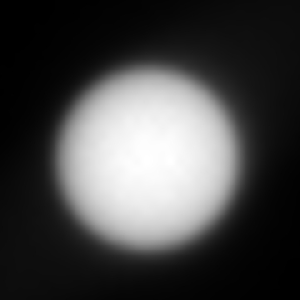Quote of the Day
Man is only born ignorant. It takes four years of college to make him stupid.
— Mark Twain
Introduction

Figure 1: Good Color Image of Phobos. (Source)
The thought of alien worlds with multiple moons has always intrigued me. I am listening to the audio book "A Princess of Mars" by Edgar Rice Burroughs. I downloaded the audio book from Libravox, which provides free downloads of readings from classic works. Normally, I do not listen to much science fiction, but I watched the movie "John Carter" and there was something I liked about the story.
In "A Princess of Mars", Burroughs describes the moons of Mars, Phobos (Figure 1) and Deimos, as being large and very bright at night.
The nights are either brilliantly illumined or very dark, for if neither of the two moons of Mars happen to be in the sky almost total darkness results, since the lack of atmosphere, or, rather, the very thin atmosphere, fails to diffuse the starlight to any great extent; on the other hand, if both of the moons are in the heavens at night the surface of the ground is brightly illuminated.
He also commented on Phobos' speed across the sky with this statement.
... the nearer moon of Barsoom raced through the western sky toward the horizon ...
I started to wonder if these characteristics were true. So I thought a few calculations would be in order ...
Background
I can believe that Phobos moves across the martian sky pretty fast, but I am not sure about the movement of Deimos. I also cannot believe that they appear to be very large in the sky. Thus, my reading has made me interested in two questions about Mars and its moons.
- How large are Phobos and Deimos as seen from Mars compared to the Moon when seen from Earth?
- How fast do the two moons move relative to each other when viewed from Mars?
Figure 2 is a good graphic that illustrates how Phobos and Deimos move about Mars. Their orbits are nearly circular and they both can transit the Sun.
Analysis
Angular Size of Phobos and Deimos Compared to the Our Moon
Figure 3 shows a transit of Phobos across the Sun (Source). Figure 4 shows the transit of Deimos across the Sun (Source).
Our Moon, as seen from Earth, has nearly the same angular extent as the Sun -- that is why we have such spectacular eclipses. However, Figure 1 and 2 show that Phobos and Deimos have significantly smaller angular extent than the Sun when viewed from Mars. Since the Sun as viewed from Mars is smaller than the Sun viewed from Earth, both Phobos and Deimos as viewed from Mars must have significantly smaller angular extent than our Moon when viewed from Earth. This qualitative argument is supported by the quantitative argument I make in Figure 5.
Size is not the only factor affecting the brightness of an object -- some objects reflect more light than others. This factor is called albedo. It turns out that the albedos of Phobos and Deimos are about half that of the Moon. Compared to the Earth's moon, the moons of Mars do not reflect much of the light that they receive.
Angular Speed of Phobos and Deimos as seen from Mars
Figure 6 shows a great time-lapse photo of Phobos and Deimos from Mars as seen by a Rover (Source). Note that Phobos and Deimos appear to move in opposite directions when viewed from the surface of Mars, even though they both revolve in the same direction around Mars. This is because of the rotation rate of Mars is slower than Phobos, but faster than Deimos. My measurements in Figure 7 show that Phobos appears to move ~12 faster than Deimos.
Figure 8 show my rough calculations that demonstrate that the relative motions measured in Figure 6 make sense when you take the rotation rate of Mars into account.
Conclusion
I think Burroughs was using some literary license when talking about how impressive the moons of Mars are at night. We can say that:
- The angular extent of the Sun is smaller at Mars than Earth
less light is available at Mars than at the Earth.
- When viewed from Mars, both Phobos and Deimos are much smaller than the Moon when viewed from Earth
less area means that light is received from the Sun, so less is available to reflect.
- Phobos and Deimos have albedo values about half that of the Moon
the moons of Mars do not reflect as much of the light they receive as the Moon does.
- These three factors (I refer to this situation as "bad cubed") means that Phobos and Deimos will reflect much less light than the Moon.
I was surprised to realize that Phobos and Deimos appear to move in opposite directions.
While the moons of Mars may not be very bright, it would still be a great view to see in person.








This is fantastic, you took the time, you rock my world. Phobos and it's contraversy made me really look into all its aspects. From conspiracy theories to more "conventional" astrometry. Its great to read all about this Moon. Thanks again! Really serves me!
Nice piece of work, so sorry to point this out but there is an error in your calculations. Although the sun seems smaller when viewed from Mars, I noticed the Phobos appears at least half the angular diameter of the Sun on the Opportunity transit video. This seems inconsistent with your calculation of angular diameter, which seems somewhat too small.
The error is that the value used for the radius of Phobos' orbit is measured from the centre of Mars, whereas we are viewing Phobos from the surface. Therefore you need to subtract the radius of Mars before you do your calculation. In other words, Phobos is orbiting 6000 km above the Martian surface, not 9000.